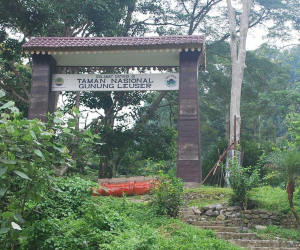Gunung Leuser National Park

Gunung Leuser National Park, sprawling across 950,000 hectares in the northern
part of Sumatra, Indonesia, encompasses the borders of North Sumatra and Aceh
provinces. The project, initiated in 1995 with assistance from the European
Union, is a vast expanse of pristine rainforest that includes several national
parks and wildlife reserves, including Gunung Leuser, Kappi, Kluet, Sikundur
Langkat Wildlife Reserve, Ketambe Research Station, Singkil Barat, and Dolok
Sembilin. The park serves as a crucial protector of diverse ecosystems and
wildlife species, acting as a sanctuary for numerous endangered animals.
Divided by the Alas River, Gunung Leuser National Park is home to approximately
700 species of animals, including 320 bird species, 176 mammals, and 194
reptiles and amphibians. Among the iconic mammals found here are the Sumatran
tiger, Sumatran rhinoceros, orangutan, Asian elephant, Malayan sun bear, and
clouded leopard.
Notably, Gunung Leuser National Park is renowned for its significant population
of Sumatran tigers, with around 400 individuals inhabiting the area. It also
serves as a vital sanctuary for the critically endangered orangutan, with two
orangutan reserves located within its boundaries.
The park boasts a rich diversity of bird species, with around 300 recorded
species, as well as an impressive array of plant life, including over 10,000
types of plants, such as the Rafflesia, the largest flower in the world, and the
Amorphophallus, the tallest flower. However, the park faces threats from illegal
logging and poaching activities.
The nearest airport to Gunung Leuser National Park is Kualanamu International
Airport (IATA: KNO, ICAO: WIMM) located in Medan, North Sumatra, approximately
150 kilometers (93 miles) away. From the airport, visitors can travel by road to
reach the park, which serves as one of the main entry points for tourists
wishing to explore this biodiverse conservation area.
Travel options from Medan to Gunung Leuser National Park include buses to
Kutacane or Bohorok-Bukit Lawang, with a journey time of 5-6 hours, or
minibusses for a faster option. Organized trekking is permitted within the park,
and visitors can arrange guides and permits through the PHPA offices, with
charges being negotiable. Trekking in the park offers a thrilling experience,
with opportunities to observe orangutans in their natural habitat, although
visitors should be prepared for frequent rainfall due to the region's cloudy
skies.
undo Indonesia Tourist Attractions